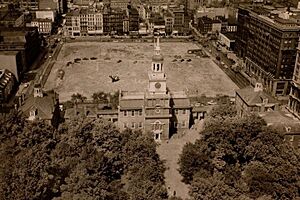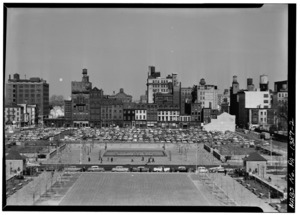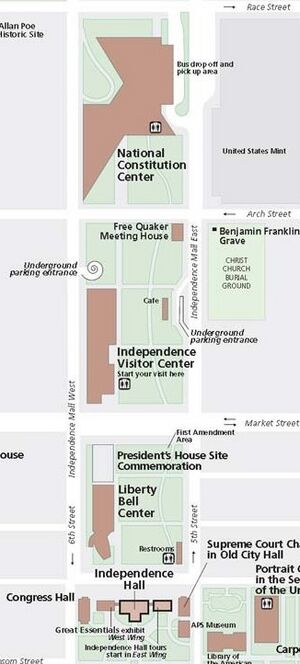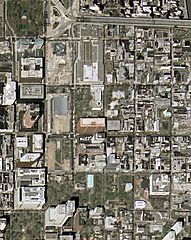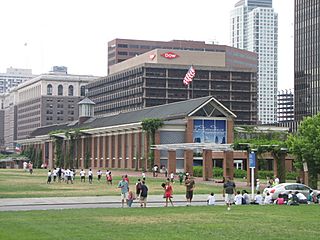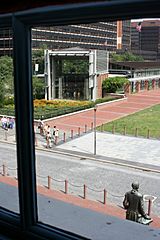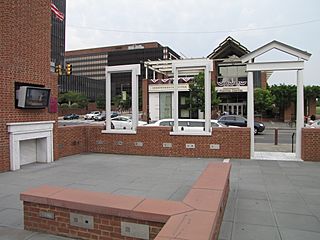Independence Mall (Philadelphia) facts for kids
Quick facts for kids
Independence Mall
|
|
|---|---|
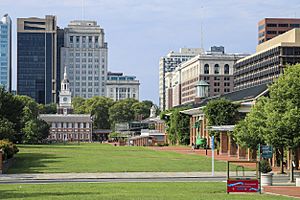
Independence Mall in 2019, seen from the National Constitution Center.
|
|
| Country | United States |
| State | Pennsylvania |
| County | Philadelphia |
| City | Philadelphia |
| Area | |
| • Land | 15.5 acre (6.3 ha) |
| Area code(s) | 215, 267 and 445 |
Independence Mall is a special three-block area in Philadelphia, Pennsylvania. It's part of the Independence National Historical Park. This important place is located just north of Independence Hall. It is bordered by Chestnut, Race, 5th, and 6th Streets.
The Mall is divided into three sections. The first section is closest to Independence Hall. The second section is in the middle. The third section is at the northern end. Many famous buildings and memorials are found here. These sites help us remember important parts of American history.
Some of the key places on the Mall include the National Constitution Center. You can also find the Independence Visitor Center and the Free Quaker Meetinghouse. The President's House Memorial and the Liberty Bell Center are also here. There's also a special area called "Peoples' Plaza." This is where people can freely express their ideas.
Contents
History of Independence Mall
How the Mall Was Planned
The idea for a park around Independence Hall began in 1935. This was when the Historic Sites Act was passed. An architect named Roy F. Larson first thought of the Mall in 1937. He imagined a large park area.
In 1947, a judge named Edwin O. Lewis pushed for the government to buy the land. He wanted the three blocks north of Independence Hall for a national park. The National Park Service (NPS) only wanted the first block. So, Judge Lewis convinced Pennsylvania to build the three-block mall as a state park.
Building the Mall
Independence Mall State Park was created in the 1950s. The plan was to eventually give the land to the NPS. Pennsylvania and Philadelphia worked together on the project. Many old buildings from the 1700s, 1800s, and 1900s were bought and taken down.
One important building that was not demolished was the Free Quaker Meetinghouse. It was moved 30 feet to the west. This allowed 5th Street to be made wider. The original designs for the Mall were made without the National Park Service.
The first block of the Mall was finished in 1954. It had a central lawn with walkways and trees. The next block featured a fountain and a reflecting pool. The northernmost block was designed by Dan Kiley. He was a famous landscape architect. His plan included many trees and fountains. However, many trees did not survive because they were too close together.
The National Park Service Takes Over
The Independence National Historic Park (INHP) was created in 1947. It officially opened to the public on July 4, 1956. At first, the Mall was not part of the National Park. In 1972, the Mall was given to the NPS. By 1974, the NPS officially owned and managed the entire Mall.
Before 1976, the Liberty Bell was inside Independence Hall. For the Bicentennial celebration in 1976, it needed a new home. Millions of visitors were expected. A new glass and steel building was built for the Bell. This building was called the Liberty Bell Pavilion.
The Liberty Bell was moved to its new home on January 1, 1976. It stayed there until October 9, 2003. In 1997, Independence Mall State Park was renamed. It is now known as Independence National Historical Park.
Modern Renovation of the Mall
A new plan for the Independence National Historical Park was created. This plan proposed removing most older structures. Only the Free Quaker Meetinghouse remained. The new design focused on placing buildings along 6th Street. Smaller parks were added along 5th Street.
These smaller parks offer quiet places to gather. They have many trees and beautiful landscaping. Straight brick paths cross the lawn areas. There is also a winding path. It connects the southeast corner to the National Constitution Center.
What You Can See Today
Today, Independence Mall still has its original three blocks. But it has many new features and buildings. Independence Hall is at the south end.
The first block is between Chestnut and Market streets. Here you will find the Liberty Bell Center. It opened in 2003. The President's House memorial is also here. At the north end of this block is the "People's Plaza." This is a large granite area. It encourages citizens to use their First Amendment rights.
The second block is between Market and Arch Streets. This block has the Independence Visitor Center. It opened in 2001. The Free Quaker Meeting House is also here. There is also a small café.
The third and final block is between Race and Arch Streets. This block is home to the National Constitution Center. It was completed in 2003.
Gallery
-
Independence Visitor Center, opened 2001.
-
National Constitution Center, opened 2003.
Images for kids
-
Statue of John Barry in Independence Square
See also
 In Spanish: Independence Mall (Filadelfia) para niños
In Spanish: Independence Mall (Filadelfia) para niños


